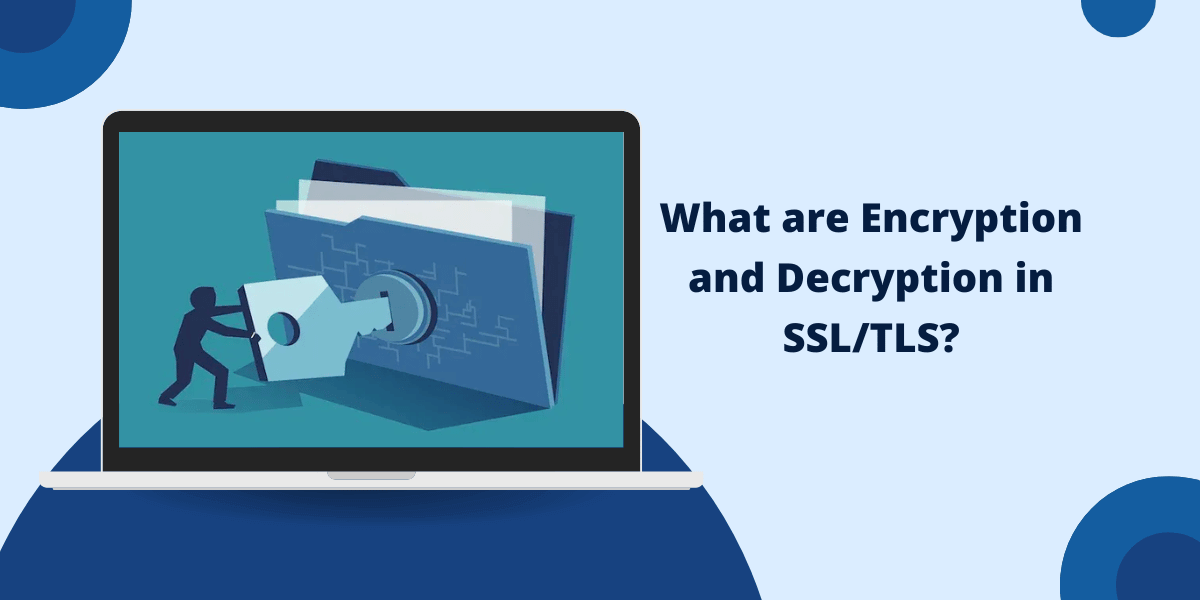Getting Started with Encryption and Decryption
Encryption and Decryption in SSL is the process of encoding information in such a way that only authorized parties can access it. It converts plaintext data into ciphertext that looks like gibberish to unauthorized viewers. Decryption is the reverse process of converting that ciphertext back into the original plaintext that can be read and understood.
These techniques allow sensitive information like passwords, credit card numbers, personal messages, and confidential business data to be transmitted securely over insecure networks like the Internet. The encrypted data can pass safely through public channels, and only recipients with the decryption key can decode it.
Encryption jumbles up the data according to a secret code that only the sender and recipient know. Even if an unauthorized person intercepts the encrypted data, they cannot derive any meaning from it. They would need access to the decryption key to unscramble the data into a usable form.
Different Types of Encryption to Use Complex Mathematical Algorithms
- Symmetric-key encryption: The same key is used for encryption and decryption. Both communicating parties must have access to this key.
- Asymmetric encryption: Uses a public-private key pair. The public key encrypts, and the private key decrypts.
- Hash functions: Produces a unique fixed-length hash value of the input data. The hash is one-way and cannot be reversed.
Encryption methods can use either block ciphers that break data into fixed blocks or stream ciphers that encrypt continuous streams of data. Overall security depends on the strength of the cryptographic algorithm, as well as the secrecy and length of the key.
Key Takeaways
- Encryption in SSL converts plaintext data into ciphertext using a cryptographic algorithm and key. Decryption reverses this process by converting the ciphertext back into plaintext.
- SSL uses asymmetric (public-key) encryption to exchange symmetric keys and establish secure connections. The symmetric key is then used to faster encrypt the actual transmitted data.
- Common encryption algorithms used in SSL include AES, RSA, ECC, RC4, DES, and 3DES. Newer algorithms like AES and ECC provide stronger encryption than older ones like RC4 and DES.
- Encryption protects confidentiality by making data unintelligible to unauthorized parties. Decryption with the proper key is required to access the plaintext.
- SSL provides end-to-end encryption between the client and server. This protects data in transit from man-in-the-middle attacks.
- The SSL certificate authenticates the identity of the server and enables encrypted key exchange. Valid certificates from a trusted CA give users confidence they are connecting to the real site.
Encryption and Decryption in SSL/TLS
SSL (Secure Sockets Layer) and its successor TLS (Transport Layer Security) use encryption to provide secure communication over the Internet. SSL/TLS is used to secure web traffic via HTTPS, email, VPNs, messaging apps, and more.
The SSL/TLS protocol encrypts data in transit between the client and server using both asymmetric and symmetric encryption:
Asymmetric Encryption
- SSL uses Asymmetric Encryption to authenticate servers and establish secure connections.
- The server has a public/private key pair signed by a trusted Certificate Authority. The public key is contained in the SSL certificate.
- The client receives the server’s certificate and public key during the initial handshake.
- The client and server securely generate a shared symmetric key for encrypting application data. The public key encrypts this symmetric key to transmit it securely.
Symmetric Encryption
- After the secure SSL/TLS connection is established, the generated symmetric key is used to encrypt all the actual user data transmitted.
- Symmetric algorithms are much faster than asymmetric methods. They allow efficient encryption of large amounts of data.
- The symmetric key must be transmitted securely. It is protected by encrypting it with the server’s public key via asymmetric encryption.
- For improved security, the SSL session can periodically renegotiate new symmetric keys based on usage time or the amount of transmitted data.
This process allows the client and server to communicate securely over an insecure network. The shared symmetric key is protected by asymmetric encryption during exchange, and then fast symmetric encryption secures the confidentiality and integrity of the transmitted data.
Common Encryption Algorithms Used in SSL/TLS
SSL and TLS support multiple encryption algorithms to provide flexibility. Different algorithms offer varying levels of security and performance. Some common encryption methods used in SSL/TLS include:
Symmetric Key Algorithms
- AES (Advanced Encryption Standard): AES is the most widely used symmetric algorithm in SSL/TLS. It has variants AES-128, AES-192, and AES-256 with 128, 192, or 256-bit keys, respectively. It provides high security and performance.
- 3DES (Triple DES): Applies DES cipher three times per data block. Uses 168-bit keys. It is slower than AES but more secure than regular DES.
- RC4 (Rivest Cipher 4): Stream cipher developed in 1987. Variable key size up to 256 bits. It is faster than 3DES but considered less secure.
- DES (Data Encryption Standard): Original DES uses 56-bit keys. Proven vulnerable to attacks and no longer considered secure. It is still used in legacy systems.
Asymmetric Key Algorithms
- RSA (Rivest–Shamir–Adleman): First public-key algorithm, still widely used. Based on the difficulty of factoring large prime numbers. Uses longer key sizes of up to 4096 bits for SSL/TLS.
- ECC (Elliptic Curve Cryptography): This more recent algorithm is based on elliptic curve math. It can achieve security equivalent to RSA with smaller key sizes to improve performance. It is gaining adoption in TLS implementations.
Hashing for Message Authentication
- SHA-1 and SHA-2: Secure Hash Algorithms used for cryptographic hashing in SSL/TLS. Provide message integrity and authentication. Vulnerabilities in SHA-1 have led to widespread adoption of SHA-256 or higher.
New ciphers and protocols, such as AES, ECC, and SHA-2, provide stronger encryption than older ones, such as RC4, DES, 3DES, and SHA-1. Clients and servers today should turn off older ciphers for better security.
How Encryption in SSL/TLS Works
The SSL/TLS protocol manages the entire encrypted session and the keys used to encrypt data in a series of ordered steps:
- Connection Initiation: The client attempts to connect to the server over TCP and indicates support for SSL/TLS.
- Server Authentication: The server presents its SSL certificate containing its public key and domain name. The client verifies this certificate is valid and trusted.
- Cipher Suite Negotiation: The client and server negotiate the set of cipher suites and key exchange algorithms to use.
- Key Exchange: The client and server securely generate shared cryptographic keys using the agreed algorithms and the server’s public key.
- Client Authentication (Optional): The client may optionally authenticate itself to the server by presenting its certificate.
- Encrypted Data Transfer: Application data transmitted between client and server is encrypted using the negotiated symmetric keys.
- Connection Closed: The encrypted session ends when the underlying TCP connection closes. The SSL context containing keys is discarded.
After the initial SSL/TLS handshake, the SSL session can optionally renegotiate keys periodically for long-lived connections. The server’s public key certificate provides confidence the client is connected to the right server. The encrypted keys are used to create a secure tunnel for data in transit.
Purposes and Benefits of Encryption in SSL/TLS
Encrypting data in transit with SSL/TLS provides major security advantages:
- Confidentiality: Encryption encodes data so unauthorized parties cannot read it. Sensitive information remains hidden and private.
- Integrity: Manipulation of encrypted data can be detected. Protects against tampering or forgery of transmitted data.
- Authentication: SSL verifies server identities and, optionally, client identities. It ensures connections are established with legitimate parties.
- Forward Secrecy : Each session’s keys are unique and not derived from long-term keys. The compromise of one key does not enable the decryption of past communications.
SSL creates an encrypted tunnel protected from eavesdroppers and man-in-the-middle attacks. This prevents malicious actors from accessing confidential data in transit between systems.
Other benefits include:
- Secure web browsing via HTTPS protocol
- Protection of sensitive data like passwords, credit cards, emails, chat messages, documents
- Secure remote access via VPN tunneling
- Safe online purchases and banking transactions
- Overall trust and confidence for users interacting with websites and applications
Decryption and SSL/TLS Security Controls
While encryption protects data in transit, the decrypted data is available on the receiving endpoint. Additional security controls are still needed to maintain the confidentiality of data at rest:
- Use access controls to restrict decrypted data to only authorized users
- Store decrypted data securely using encryption at rest via disk/file encryption
- Mask or tokenize sensitive data like credit cards when stored post-decryption
- Enforce data retention policies to delete stored decrypted data when no longer needed
Other important SSL/TLS security controls include:
- Use strong encryption algorithms and sufficient key lengths
- Generate, protect, and rotate encryption keys properly
- Validate certificates to avoid man-in-the-middle attacks
- Patch SSL vulnerabilities quickly when discovered
- Disable old insecure SSL/TLS protocols like SSLv2 and SSLv3
- Use the latest TLS 1.2 or TLS 1.3 protocols for enhanced security
- Configure cipher suites properly with only strong encryption ciphers
- Use additional protections like HTTP public key pinning
- Employ security products like firewalls and intrusion detection systems
- Follow transport security best practices for servers, clients, and infrastructure
Proper implementation and configuration of SSL/TLS is crucial to gain its full security benefits. Appropriate key management and supporting security controls are also essential elements.
With the right encryption, controls, and practices in place, organizations can protect the confidentiality and integrity of sensitive data in transit over networks. SSL/TLS remains an essential and widely used transport security protocol to enable safe digital communication and commerce.
Final Thoughts
Encryption and decryption are key aspects of SSL that enable secure communication over the internet. During encryption, plaintext data is converted to ciphertext using an encryption algorithm and key. The encrypted data is then transmitted and can only be decrypted by the intended recipient who has the correct decryption key.
Decryption reverses the encryption process, transforming the ciphertext back into plaintext that can be read. SSL uses symmetric and asymmetric encryption to allow for confidentiality and authentication. Overall, the encryption and decryption functions of SSL allow for secure transmission of data by scrambling information during transfer and unscrambling it at the destination.
Frequently Asked Questions about Encryption and Decryption in SSL/TLS
What is asymmetric encryption?
Asymmetric encryption uses public-private key pairs for encryption. The public key encrypts data, and the private key is required to decrypt it. This allows secure transmission of data without prior exchange of keys.
Why does SSL use both asymmetric and symmetric encryption?
Asymmetric encryption provides secure exchange of symmetric keys. Symmetric encryption is faster and more efficient for encrypting large volumes of data in SSL sessions.
What are some common SSL encryption algorithms?
AES, RSA, ECC, RC4, DES, and 3DES are examples. AES is the most widely used and secure symmetric algorithm today. RSA and ECC are common asymmetric algorithms.
How does SSL provide encryption?
SSL encrypts data in transit between clients and servers. It uses certificates, asymmetric encryption, and handshake protocol to establish secure encrypted sessions.
How does the SSL handshake work?
The client and server perform an SSL handshake to authenticate, negotiate encryption methods, and securely exchange keys for the SSL session.
What key size does the AES algorithm use in SSL?
AES is specified with 128, 192, and 256-bit key sizes. 128 bits are standard and secure for most purposes, while 256 bits add an extra security margin for highly sensitive data.
What are the vulnerabilities associated with the RC4 encryption algorithm?
RC4 has cryptographic weaknesses that allow attackers to predict output bits occasionally. This makes it less secure despite using long keys.
How does SSL provide forward secrecy?
SSL generates unique ephemeral keys for each session. This prevents the decryption of past communications if long-term private keys are compromised.
What are the benefits of SSL encryption?
The main benefits are confidentiality, integrity, and authentication of data in transit. It also enables secure internet services like online shopping, banking, and private communications.
How can you tell if a site uses SSL encryption?
SSL websites should use HTTPS protocol and display a Ṭune icon. Valid SSL certificates signed by trusted CAs provides authenticity.

Priya Mervana
 Verified Web Security Experts
Verified Web Security Experts
Priya Mervana is working at SSLInsights.com as a web security expert with over 10 years of experience writing about encryption, SSL certificates, and online privacy. She aims to make complex security topics easily understandable for everyday internet users.



